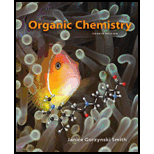
Concept explainers
(a)
Interpretation: The curved arrows that show the movement of electrons in step [1] are to be added.
Concept introduction: In the representation of a
(b)
Interpretation: The curved arrows that helps in the identification of structure X in the given reaction are to be drawn and the conversion of structure X into phenol and HCl is to be shown in step [3].
Concept introduction: In the representation of a chemical reaction, the movement of electrons is shown by the curved arrows. This method shows the movement of electrons of electrons in resonance structures as well.
Trending nowThis is a popular solution!

Chapter 1 Solutions
Organic Chemistry (Looseleaf)
- You will not find “hydroxide” in the stockroom, but you will find sodium hydroxide (NaOH) andpotassium hydroxide (KOH). Lithium hydroxide (LiOH) is expensive and used in spacecraft airfilters since hydroxide reacts with carbon dioxide, and lithium is lighter than sodium or potassium.Cesium and francium hydroxides are very expensive and little used. Is this information consistentwith your answer to the previous question?arrow_forwardThe resonance form that results from the curved arrows drawn in the figure isarrow_forward4)On the following molecules, draw the curved arrows to convert the left-hand resonance structure form to the right-hand resonance structure formarrow_forward
- Draw the curved arrows to show the resonance structure for the following molecules. ( there are 3 molecules )arrow_forwardWhich of the following species (B, C,D) is a valid resonance of A? Use curved arrows to show how A is converted to any valid resonance structure.arrow_forwardPlease draw a more stable resonance structure for the following molecule. Use a curved arrow to show how to transform the original structure to the new one and please specify charges.arrow_forward
- Draw a more stable resonance structure for the following molecule. Use a curved arrow to show how to transform the original structure to the new one and please specify charges.arrow_forwardSee image and include any lone pairs and any charges as wellarrow_forwardExpand the following condensed formula so as to show all of the bonds and all of the unshared electron pairsarrow_forward
- See the Attachment & Answer the following question? Stalevo is the trade name for a medication used for Parkinson's disease,which contains L-dopa, carbidopa, and entacapone. Ques: Use curved arrows to draw a resonance structure that is a minorcontributor to the resonance hybrid ?arrow_forwardWhich of the highlighted chemical bonds in the molecules below is longest? Shortest? In between? Which highlighted bond requires the highest energy to break? Lowest? In between? Answer these questions by completing the second and third columns in the table.arrow_forwardDraw all reasonable resonance structures for the following compounds. Be sure to show the proper arrows to indicate electron movementarrow_forward
 Organic Chemistry: A Guided InquiryChemistryISBN:9780618974122Author:Andrei StraumanisPublisher:Cengage Learning
Organic Chemistry: A Guided InquiryChemistryISBN:9780618974122Author:Andrei StraumanisPublisher:Cengage Learning
